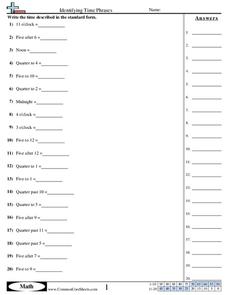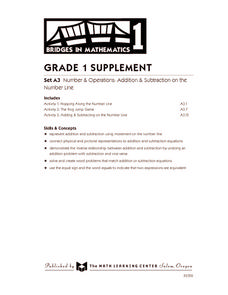Common Core Sheets
Matching Clocks (5 Minute Increments)
Second graders match the time on an analog clock to the time on a digital clock. Each sheet has 16 problems for solving.
Common Core Sheets
Creating Clocks (Half Hour Increments)
First graders create clocks by adding hour and minute hands pointing to the given time. All times are to be written in 30-minute intervals.
Common Core Sheets
Finding Elapsed Time
Third graders read word problems to determine the elapsed time, given the start and end time.
Common Core Sheets
Finding Starting Time
Third graders read word problems to determine the start time, given the elapsed time and end time.
Common Core Sheets
Reading an Analog Clock (1 Minute Increments)
Third graders read analog clocks and tell time to the nearest minute. AM and PM do not matter in this exercise.
Common Core Sheets
Identifying Time Phrases
Quarter to seven. Noon. Five after three. These are a few examples of the time phrases learners must identify. Most of the times to not indicate AM or PM; however, noon and midnight should be identified appropriately.
Common Core Sheets
Matching Clocks (Half Hour Increments)
First graders read an analog clock and then match it to the corresponding digital clock. Each clock tells time to the nearest 30 minutes.
Common Core Sheets
Reading an Analog Clock (5 Minute Increments)
Second and third graders practice reading analog clocks to the nearest five minutes.
Common Core Sheets
Creating Area and Perimeter Rectangles
Third graders are challenged to draw their own rectangles given a specific area or perimeter. There are no examples of how each rectangle should look, so it is important for learners to persevere in finding a solution. There is more than...
Common Core Sheets
Rectangles - Same Perimeter and Different Area
Given a rectangle with specified dimensions, learners are prompted to create a new rectangle with the same perimeter, but a different area. This challenges third graders to think about perimeter and area in a new way. Each problem...
Common Core Sheets
Rectangles - Same Area and Different Perimeter
Given a rectangle with specified dimensions, third graders are prompted to create a new rectangle with the same area, but a different perimeter. This challenges learners to think about perimeter and area in a new way. Use worksheet as a...
Common Core Sheets
Determining Area with Partial Blocks
A more challenging set of worksheets, third graders are required to measure area by counting whole and partial unit squares. Students will realize that two partial blocks make up one whole block. Each shaded figure is on a square unit grid.
Common Core Sheets
Determining Rectilinear Area
Third graders find the area of rectilinear shapes by partitioning them into two non-overlapping rectangles and adding the areas of the non-overlapping parts together. It allows learners to recognize area as an additive.
Common Core Sheets
Determining Area with Full Blocks
Third graders simply count the square units that make up each figure in order to find the area. Remind the class to count carefully in order to find the correct answer.
Common Core Sheets
Determining Area with Square Units
Third graders measure area by counting unit squares inside a rectangle.
Common Core Sheets
Finding Area by Tiling
Third graders find area by tiling a rectangle based on the given side lengths. This helps learners visualize and create the area of a figure. From here, they can count the total number of tiles inside the rectangle to find the answer.
Common Core Sheets
Determining Perimeter with Square Units
Third graders determine the perimeter of a shaded section by counting the number of unit squares that surround it. Each section is shaded on a small square unit grid.
Common Core Sheets
Finding Side Length (Given Area)
Area is the amount of space that takes up the inside of a figure. To find the area of a rectangle, one must multiply the length by the width. Here, third graders are challenged to find the missing side length, given the area.
Common Core Sheets
Finding Side Length (Given Perimeter)
Perimeter is the total distance around an object. One can find the perimeter of a rectangle or square by adding all four side lengths together. These worksheets require third graders to find the missing side length, given the perimeter...
Teacher's Corner
What Is a Foot?
An in-class and at-home assignment, young math stars find and list items from home and school that they think are one foot in length. Once the list is made, provide everyone with rulers to measure and find the actual lengths of their items.
For the Teachers
$1 Math
Captivate your class by having them find the value of their names, different zoo animals, musical instruments, etc.,with a mental math lesson. Using the coding formula listed, children learn to fluently estimate and calculate simple sums.
Houghton Mifflin Harcourt
Protractors
Did your students forget to bring their protractors to class again? Using this resourceful copy of four identical protractors, you can easily make a class set or let your students take them home.
New York City Department of Education
Project Based Learning
After reviewing the information included in this resource, you will be an expert in both the definition of project-based learning and how to implement it with your class. Discover and explore thorough explanations, detailed examples, and...
Math Learning Center
Grade 1 Supplement Set A3 - Number and Operations: Addition and Subtraction on the Number Line
Hop your way through a mathematical equation with your first grade class as they learn the idea of moving up and down the number line. Adding and subtracting like little frogs is an engaging and clever way to teach/reinforce this concept.

























